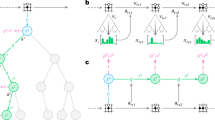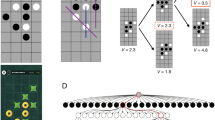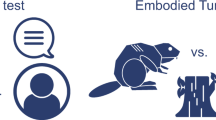Abstract
A long-standing goal of artificial intelligence is an algorithm that learns, tabula rasa, superhuman proficiency in challenging domains. Recently, AlphaGo became the first program to defeat a world champion in the game of Go. The tree search in AlphaGo evaluated positions and selected moves using deep neural networks. These neural networks were trained by supervised learning from human expert moves, and by reinforcement learning from self-play. Here we introduce an algorithm based solely on reinforcement learning, without human data, guidance or domain knowledge beyond game rules. AlphaGo becomes its own teacher: a neural network is trained to predict AlphaGo’s own move selections and also the winner of AlphaGo’s games. This neural network improves the strength of the tree search, resulting in higher quality move selection and stronger self-play in the next iteration. Starting tabula rasa, our new program AlphaGo Zero achieved superhuman performance, winning 100–0 against the previously published, champion-defeating AlphaGo.
This is a preview of subscription content, access via your institution
Access options
Access Nature and 54 other Nature Portfolio journals
Get Nature+, our best-value online-access subscription
$29.99 / 30 days
cancel any time
Subscribe to this journal
Receive 51 print issues and online access
$199.00 per year
only $3.90 per issue
Buy this article
- Purchase on Springer Link
- Instant access to full article PDF
Prices may be subject to local taxes which are calculated during checkout






Similar content being viewed by others
References
Friedman, J., Hastie, T. & Tibshirani, R. The Elements of Statistical Learning: Data Mining, Inference, and Prediction (Springer, 2009)
LeCun, Y., Bengio, Y. & Hinton, G. Deep learning. Nature 521, 436–444 (2015)
Krizhevsky, A., Sutskever, I. & Hinton, G. ImageNet classification with deep convolutional neural networks. In Adv. Neural Inf. Process. Syst. Vol. 25 (eds Pereira, F., Burges, C. J. C., Bottou, L. & Weinberger, K. Q. ) 1097–1105 (2012)
He, K., Zhang, X., Ren, S . & Sun, J. Deep residual learning for image recognition. In Proc. 29th IEEE Conf. Comput. Vis. Pattern Recognit. 770–778 (2016)
Hayes-Roth, F., Waterman, D. & Lenat, D. Building Expert Systems (Addison-Wesley, 1984)
Mnih, V. et al. Human-level control through deep reinforcement learning. Nature 518, 529–533 (2015)
Guo, X., Singh, S. P., Lee, H., Lewis, R. L. & Wang, X. Deep learning for real-time Atari game play using offline Monte-Carlo tree search planning. In Adv. Neural Inf. Process. Syst. Vol. 27 (eds Ghahramani, Z., Welling, M., Cortes, C., Lawrence, N. D. & Weinberger, K. Q. ) 3338–3346 (2014)
Mnih, V . et al. Asynchronous methods for deep reinforcement learning. In Proc. 33rd Int. Conf. Mach. Learn. Vol. 48 (eds Balcan, M. F. & Weinberger, K. Q. ) 1928–1937 (2016)
Jaderberg, M . et al. Reinforcement learning with unsupervised auxiliary tasks. In 5th Int. Conf. Learn. Representations (2017)
Dosovitskiy, A. & Koltun, V. Learning to act by predicting the future. In 5th Int. Conf. Learn. Representations (2017)
Man´dziuk, J. in Challenges for Computational Intelligence ( Duch, W. & Man´dziuk, J. ) 407–442 (Springer, 2007)
Silver, D. et al. Mastering the game of Go with deep neural networks and tree search. Nature 529, 484–489 (2016)
Coulom, R. Efficient selectivity and backup operators in Monte-Carlo tree search. In 5th Int. Conf. Computers and Games (eds Ciancarini, P. & van den Herik, H. J. ) 72–83 (2006)
Kocsis, L. & Szepesvári, C. Bandit based Monte-Carlo planning. In 15th Eu. Conf. Mach. Learn. 282–293 (2006)
Browne, C. et al. A survey of Monte Carlo tree search methods. IEEE Trans. Comput. Intell. AI Games 4, 1–49 (2012)
Fukushima, K. Neocognitron: a self organizing neural network model for a mechanism of pattern recognition unaffected by shift in position. Biol. Cybern. 36, 193–202 (1980)
LeCun, Y. & Bengio, Y. in The Handbook of Brain Theory and Neural Networks Ch. 3 (ed. Arbib, M. ) 276–278 (MIT Press, 1995)
Ioffe, S. & Szegedy, C. Batch normalization: accelerating deep network training by reducing internal covariate shift. In Proc. 32nd Int. Conf. Mach. Learn. Vol. 37 448–456 (2015)
Hahnloser, R. H. R., Sarpeshkar, R., Mahowald, M. A., Douglas, R. J. & Seung, H. S. Digital selection and analogue amplification coexist in a cortex-inspired silicon circuit. Nature 405, 947–951 (2000)
Howard, R. Dynamic Programming and Markov Processes (MIT Press, 1960)
Sutton, R . & Barto, A. Reinforcement Learning: an Introduction (MIT Press, 1998)
Bertsekas, D. P. Approximate policy iteration: a survey and some new methods. J. Control Theory Appl. 9, 310–335 (2011)
Scherrer, B. Approximate policy iteration schemes: a comparison. In Proc. 31st Int. Conf. Mach. Learn. Vol. 32 1314–1322 (2014)
Rosin, C. D. Multi-armed bandits with episode context. Ann. Math. Artif. Intell. 61, 203–230 (2011)
Coulom, R. Whole-history rating: a Bayesian rating system for players of time-varying strength. In Int. Conf. Comput. Games (eds van den Herik, H. J., Xu, X . Ma, Z . & Winands, M. H. M. ) Vol. 5131 113–124 (Springer, 2008)
Laurent, G. J., Matignon, L. & Le Fort-Piat, N. The world of independent learners is not Markovian. Int. J. Knowledge-Based Intelligent Engineering Systems 15, 55–64 (2011)
Foerster, J. N . et al. Stabilising experience replay for deep multi-agent reinforcement learning. In Proc. 34th Int. Conf. Mach. Learn. Vol. 70 1146–1155 (2017)
Heinrich, J . & Silver, D. Deep reinforcement learning from self-play in imperfect-information games. In NIPS Deep Reinforcement Learning Workshop (2016)
Jouppi, N. P . et al. In-datacenter performance analysis of a Tensor Processing Unit. Proc. 44th Annu. Int. Symp. Comp. Architecture Vol. 17 1–12 (2017)
Maddison, C. J., Huang, A., Sutskever, I . & Silver, D. Move evaluation in Go using deep convolutional neural networks. In 3rd Int. Conf. Learn. Representations. (2015)
Clark, C . & Storkey, A. J. Training deep convolutional neural networks to play Go. In Proc. 32nd Int. Conf. Mach. Learn. Vol. 37 1766–1774 (2015)
Tian, Y. & Zhu, Y. Better computer Go player with neural network and long-term prediction. In 4th Int. Conf. Learn. Representations (2016)
Cazenave, T. Residual networks for computer Go. IEEE Trans. Comput. Intell. AI Games https://doi.org/10.1109/TCIAIG.2017.2681042 (2017)
Huang, A. AlphaGo master online series of games. https://deepmind.com/research/AlphaGo/match-archive/master (2017)
Barto, A. G. & Duff, M. Monte Carlo matrix inversion and reinforcement learning. Adv. Neural Inf. Process. Syst. 6, 687–694 (1994)
Singh, S. P. & Sutton, R. S. Reinforcement learning with replacing eligibility traces. Mach. Learn. 22, 123–158 (1996)
Lagoudakis, M. G. & Parr, R. Reinforcement learning as classification: leveraging modern classifiers. In Proc. 20th Int. Conf. Mach. Learn. 424–431 (2003)
Scherrer, B., Ghavamzadeh, M., Gabillon, V., Lesner, B. & Geist, M. Approximate modified policy iteration and its application to the game of Tetris. J. Mach. Learn. Res. 16, 1629–1676 (2015)
Littman, M. L. Markov games as a framework for multi-agent reinforcement learning. In Proc. 11th Int. Conf. Mach. Learn. 157–163 (1994)
Enzenberger, M. The integration of a priori knowledge into a Go playing neural network. http://www.cgl.ucsf.edu/go/Programs/neurogo-html/neurogo.html (1996)
Enzenberger, M. in Advances in Computer Games (eds Van Den Herik, H. J., Iida, H. & Heinz, E. A. ) 97–108 (2003)
Sutton, R. Learning to predict by the method of temporal differences. Mach. Learn. 3, 9–44 (1988)
Schraudolph, N. N., Dayan, P. & Sejnowski, T. J. Temporal difference learning of position evaluation in the game of Go. Adv. Neural Inf. Process. Syst. 6, 817–824 (1994)
Silver, D., Sutton, R. & Müller, M. Temporal-difference search in computer Go. Mach. Learn. 87, 183–219 (2012)
Silver, D. Reinforcement Learning and Simulation-Based Search in Computer Go. PhD thesis, Univ. Alberta, Edmonton, Canada (2009)
Gelly, S. & Silver, D. Monte-Carlo tree search and rapid action value estimation in computer Go. Artif. Intell. 175, 1856–1875 (2011)
Coulom, R. Computing Elo ratings of move patterns in the game of Go. Int. Comput. Games Assoc. J. 30, 198–208 (2007)
Gelly, S., Wang, Y., Munos, R. & Teytaud, O. Modification of UCT with patterns in Monte-Carlo Go. Report No. 6062 (INRIA, 2006)
Baxter, J., Tridgell, A. & Weaver, L. Learning to play chess using temporal differences. Mach. Learn. 40, 243–263 (2000)
Veness, J., Silver, D., Blair, A. & Uther, W. Bootstrapping from game tree search. In Adv. Neural Inf. Process. Syst. 1937–1945 (2009)
Lai, M. Giraffe: Using Deep Reinforcement Learning to Play Chess. MSc thesis, Imperial College London (2015)
Schaeffer, J., Hlynka, M . & Jussila, V. Temporal difference learning applied to a high-performance game-playing program. In Proc. 17th Int. Jt Conf. Artif. Intell. Vol. 1 529–534 (2001)
Tesauro, G. TD-gammon, a self-teaching backgammon program, achieves master-level play. Neural Comput. 6, 215–219 (1994)
Buro, M. From simple features to sophisticated evaluation functions. In Proc. 1st Int. Conf. Comput. Games 126–145 (1999)
Sheppard, B. World-championship-caliber Scrabble. Artif. Intell. 134, 241–275 (2002)
Moravcˇík, M. et al. DeepStack: expert-level artificial intelligence in heads-up no-limit poker. Science 356, 508–513 (2017)
Tesauro, G & Galperin, G. On-line policy improvement using Monte-Carlo search. In Adv. Neural Inf. Process. Syst. 1068–1074 (1996)
Tesauro, G. Neurogammon: a neural-network backgammon program. In Proc. Int. Jt Conf. Neural Netw. Vol. 3, 33–39 (1990)
Samuel, A. L. Some studies in machine learning using the game of checkers II - recent progress. IBM J. Res. Develop. 11, 601–617 (1967)
Kober, J., Bagnell, J. A. & Peters, J. Reinforcement learning in robotics: a survey. Int. J. Robot. Res. 32, 1238–1274 (2013)
Zhang, W. & Dietterich, T. G. A reinforcement learning approach to job-shop scheduling. In Proc. 14th Int. Jt Conf. Artif. Intell. 1114–1120 (1995)
Cazenave, T., Balbo, F. & Pinson, S. Using a Monte-Carlo approach for bus regulation. In Int. IEEE Conf. Intell. Transport. Syst. 1–6 (2009)
Evans, R. & Gao, J. Deepmind AI reduces Google data centre cooling bill by 40%. https://deepmind.com/blog/deepmind-ai-reduces-google-data-centre-cooling-bill-40/ (2016)
Abe, N . et al. Empirical comparison of various reinforcement learning strategies for sequential targeted marketing. In IEEE Int. Conf. Data Mining 3–10 (2002)
Silver, D., Newnham, L., Barker, D., Weller, S. & McFall, J. Concurrent reinforcement learning from customer interactions. In Proc. 30th Int. Conf. Mach. Learn. Vol. 28 924–932 (2013)
Tromp, J. Tromp–Taylor rules. http://tromp.github.io/go.html (1995)
Müller, M. Computer Go. Artif. Intell. 134, 145–179 (2002)
Shahriari, B., Swersky, K., Wang, Z., Adams, R. P. & de Freitas, N. Taking the human out of the loop: a review of Bayesian optimization. Proc. IEEE 104, 148–175 (2016)
Segal, R. B. On the scalability of parallel UCT. Comput. Games 6515, 36–47 (2011)
Acknowledgements
We thank A. Cain for work on the visuals; A. Barreto, G. Ostrovski, T. Ewalds, T. Schaul, J. Oh and N. Heess for reviewing the paper; and the rest of the DeepMind team for their support.
Author information
Authors and Affiliations
Contributions
D.S., J.S., K.S., I.A., A.G., L.S. and T.H. designed and implemented the reinforcement learning algorithm in AlphaGo Zero. A.H., J.S., M.L. and D.S. designed and implemented the search in AlphaGo Zero. L.B., J.S., A.H., F.H., T.H., Y.C. and D.S. designed and implemented the evaluation framework for AlphaGo Zero. D.S., A.B., F.H., A.G., T.L., T.G., L.S., G.v.d.D. and D.H. managed and advised on the project. D.S., T.G. and A.G. wrote the paper.
Corresponding author
Ethics declarations
Competing interests
The authors declare no competing financial interests.
Additional information
Reviewer Information Nature thanks S. Singh and the other anonymous reviewer(s) for their contribution to the peer review of this work.
Publisher's note: Springer Nature remains neutral with regard to jurisdictional claims in published maps and institutional affiliations.
Extended data figures and tables
Extended Data Figure 1 Tournament games between AlphaGo Zero (20 blocks, 3 days) versus AlphaGo Lee using 2 h time controls.
One hundred moves of the first 20 games are shown; full games are provided in the Supplementary Information.
Extended Data Figure 2 Frequency of occurence over time during training, for each joseki from Fig. 5a (corner sequences common in professional play that were discovered by AlphaGo Zero).
The corresponding joseki are shown on the right.
Extended Data Figure 3 Frequency of occurence over time during training, for each joseki from Fig. 5b (corner sequences that AlphaGo Zero favoured for at least one iteration), and one additional variation.
The corresponding joseki are shown on the right.
Extended Data Figure 4 AlphaGo Zero (20 blocks) self-play games.
The 3-day training run was subdivided into 20 periods. The best player from each period (as selected by the evaluator) played a single game against itself, with 2 h time controls. One hundred moves are shown for each game; full games are provided in the Supplementary Information.
Extended Data Figure 5 AlphaGo Zero (40 blocks) self-play games.
The 40-day training run was subdivided into 20 periods. The best player from each period (as selected by the evaluator) played a single game against itself, with 2 h time controls. One hundred moves are shown for each game; full games are provided in the Supplementary Information.
Extended Data Figure 6 AlphaGo Zero (40 blocks, 40 days) versus AlphaGo Master tournament games using 2 h time controls.
One hundred moves of the first 20 games are shown; full games are provided in the Supplementary Information.
Supplementary information
Supplementary Data
This zipped file contains the game records of self-play and tournament games played by AlphaGo Zero in .sgf format. (ZIP 82 kb)
Rights and permissions
About this article
Cite this article
Silver, D., Schrittwieser, J., Simonyan, K. et al. Mastering the game of Go without human knowledge. Nature 550, 354–359 (2017). https://doi.org/10.1038/nature24270
Received:
Accepted:
Published:
Issue Date:
DOI: https://doi.org/10.1038/nature24270
This article is cited by
-
Solving real-world optimization tasks using physics-informed neural computing
Scientific Reports (2024)
-
Diagnosing glaucoma in primary eye care and the role of Artificial Intelligence applications for reducing the prevalence of undetected glaucoma in Australia
Eye (2024)
-
High-efficiency reinforcement learning with hybrid architecture photonic integrated circuit
Nature Communications (2024)
-
Rigor with machine learning from field theory to the Poincaré conjecture
Nature Reviews Physics (2024)
-
A deep learning method for empirical spectral prediction and inverse design of all-optical nonlinear plasmonic ring resonator switches
Scientific Reports (2024)
Comments
By submitting a comment you agree to abide by our Terms and Community Guidelines. If you find something abusive or that does not comply with our terms or guidelines please flag it as inappropriate.



